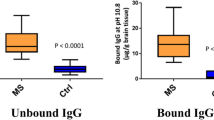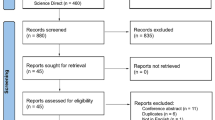Abstract
One of the great challenges related to multiple sclerosis (MS) research is the identification of markers of prognosis and treatment response. In the last couple of decades, an association between intrathecally produced immunoglobulin M (IgM) and a more severe course of the disease has been suggested. Therefore, the objective of this literature review was to gather and review evidence from studies on intrathecally produced IgM as a prognostic marker of clinically isolated syndrome (CIS) converting to clinically definite MS (CDMS), the prognosis of MS and treatment response in patients with MS. This was accomplished through a systematic literature search of the PubMed database, which resulted in 719 hits that were then systematically assessed with well-defined inclusion and exclusion criteria. This process resulted in 29 relevant research articles. The combined evidence from the current literature suggests that intrathecal IgM is a negative prognostic marker that identifies patients with CIS who have a higher risk of converting to CDMS and patients with relapsing–remitting MS (RRMS) with a higher risk of a more aggressive disease course. However, a few studies, some with large studied populations, have reported conflicting results regarding MS prognosis. Further research is needed to establish a more accurate estimate of the effect of intrathecal IgM on the disease course of MS. Further research is also necessary to evaluate the potential prognostic value of intrathecal IgM in treatment response.

Similar content being viewed by others
References
Noyes K, Weinstock-Guttman B. Impact of diagnosis and early treatment on the course of multiple sclerosis. Am J Manag Care. 2013;19(17 Suppl):s321–31.
Thompson AJ, et al. Diagnosis of multiple sclerosis: 2017 revisions of the McDonald criteria. Lancet Neurol. 2018;17(2):162–73.
Andersson M, et al. Cerebrospinal fluid in the diagnosis of multiple sclerosis: a consensus report. J Neurol Neurosurg Psychiatry. 1994;57(8):897–902.
Sharief MK, Thompson EJ. Intrathecal immunoglobulin M synthesis in multiple sclerosis. Relationship with clinical and cerebrospinal fluid parameters. Brain. 1991;114(Pt 1A):181–95.
Sindic CJ, Monteyne P, Laterre EC. Occurrence of oligoclonal IgM bands in the cerebrospinal fluid of neurological patients: an immunoaffinity-mediated capillary blot study. J Neurol Sci. 1994;124(2):215–9.
Lucchinetti C, et al. Heterogeneity of multiple sclerosis lesions: implications for the pathogenesis of demyelination. Ann Neurol. 2000;47(6):707–17.
Bosca I, et al. The risk of relapse after a clinically isolated syndrome is related to the pattern of oligoclonal bands. J Neuroimmunol. 2010;226(1–2):143–6.
Calabrese M, et al. The association of intrathecal immunoglobulin synthesis and cortical lesions predicts disease activity in clinically isolated syndrome and early relapsing-remitting multiple sclerosis. Mult Scler. 2012;18(2):174–80.
Durante L, et al. Intrathecal synthesis of IgM measured after a first demyelinating event suggestive of multiple sclerosis is associated with subsequent MRI brain lesion accrual. Mult Scler. 2012;18(5):587–91.
Ferraro D, et al. Cerebrospinal fluid oligoclonal IgM bands predict early conversion to clinically definite multiple sclerosis in patients with clinically isolated syndrome. J Neuroimmunol. 2013;257(1–2):76–81.
Huss A, et al. Intrathecal immunoglobulin M production: a promising high-risk marker in clinically isolated syndrome patients. Ann Neurol. 2018;83(5):1032–6.
Magraner MJ, et al. Brain atrophy and lesion load are related to CSF lipid-specific IgM oligoclonal bands in clinically isolated syndromes. Neuroradiology. 2012;54(1):5–12.
Pfuhl C, et al. Intrathecal IgM production is a strong risk factor for early conversion to multiple sclerosis. Neurology. 2019;93(15):e1439–51.
Schneider R, Euler B, Rauer S. Intrathecal IgM-synthesis does not correlate with the risk of relapse in patients with a primary demyelinating event. Eur J Neurol. 2007;14(8):907–11.
Sharief MK, Thompson EJ. The predictive value of intrathecal immunoglobulin synthesis and magnetic resonance imaging in acute isolated syndromes for subsequent development of multiple sclerosis. Ann Neurol. 1991;29(2):147–51.
Tejeda-Velarde A, et al. Clinical usefulness of prognostic biomarkers in optic neuritis. Eur J Neurol. 2018;25(4):614–8.
Villar L, et al. Influence of oligoclonal IgM specificity in multiple sclerosis disease course. Mult Scler. 2008;14(2):183–7.
Ferraro D, et al. Cerebrospinal fluid CXCL13 in clinically isolated syndrome patients: association with oligoclonal IgM bands and prediction of Multiple Sclerosis diagnosis. J Neuroimmunol. 2015;283:64–9.
Abdelhak A, et al. CSF profile in primary progressive multiple sclerosis: re-exploring the basics. PLoS One. 2017;12(8):e0182647.
Frau J, et al. Intrathecal oligoclonal bands synthesis in multiple sclerosis: is it always a prognostic factor? J Neurol. 2018;265(2):424–30.
Gasperi C, et al. Association of intrathecal immunoglobulin G synthesis with disability worsening in multiple sclerosis. JAMA Neurol. 2019;76(7):841–9.
Gil-Perotin S, et al. Combined cerebrospinal fluid neurofilament light chain protein and chitinase-3 like-1 levels in defining disease course and prognosis in multiple sclerosis. Front Neurol. 2019;10:1008.
Klein A, et al. CSF parameters associated with early MRI activity in patients with MS. Neurol Neuroimmunol Neuroinflamm. 2019;6(4):e573.
Mandrioli J, et al. A multifactorial prognostic index in multiple sclerosis. Cerebrospinal fluid IgM oligoclonal bands and clinical features to predict the evolution of the disease. J Neurol. 2008;255(7):1023–31.
Perini P, et al. Intrathecal IgM production at clinical onset correlates with a more severe disease course in multiple sclerosis. J Neurol Neurosurg Psychiatry. 2006;77(8):953–5.
Sola P, et al. Primary progressive versus relapsing-onset multiple sclerosis: presence and prognostic value of cerebrospinal fluid oligoclonal IgM. Mult Scler. 2011;17(3):303–11.
Stauch C, et al. Intrathecal IgM synthesis in pediatric MS is not a negative prognostic marker of disease progression: quantitative versus qualitative IgM analysis. Mult Scler. 2011;17(3):327–34.
Thangarajh M, et al. Lipid-specific immunoglobulin M in CSF predicts adverse long-term outcome in multiple sclerosis. Mult Scler. 2008;14(9):1208–13.
Villar LM, et al. Intrathecal IgM synthesis predicts the onset of new relapses and a worse disease course in MS. Neurology. 2002;59(4):555–9.
Villar LM, et al. Intrathecal IgM synthesis is a prognostic factor in multiple sclerosis. Ann Neurol. 2003;53(2):222–6.
Villar LM, et al. Intrathecal synthesis of oligoclonal IgM against myelin lipids predicts an aggressive disease course in MS. J Clin Invest. 2005;115(1):187–94.
Bosca I, et al. Response to interferon in multiple sclerosis is related to lipid-specific oligoclonal IgM bands. Mult Scler. 2010;16(7):810–5.
Casanova B, et al. Different clinical response to interferon beta and glatiramer acetate related to the presence of oligoclonal IgM bands in CSF in multiple sclerosis patients. Neurol Sci. 2018;39(8):1423–30.
Garcia-Barragan N, et al. Multiple sclerosis patients with anti-lipid oligoclonal IgM show early favourable response to immunomodulatory treatment. Eur J Neurol. 2009;16(3):380–5.
Villar LM, et al. Immunoglobulin M oligoclonal bands: biomarker of targetable inflammation in primary progressive multiple sclerosis. Ann Neurol. 2014;76(2):231–40.
Correale J, de los Molinas MB. Oligoclonal bands and antibody responses in multiple sclerosis. J Neurol. 2002;249(4):375–89.
Breij EC, et al. Homogeneity of active demyelinating lesions in established multiple sclerosis. Ann Neurol. 2008;63(1):16–25.
Thorne S, Con A, McGuinness L, McPherson G, Harris SR. Health care communication issues in multiple sclerosis: an interpretive description. Qual Health Res. 2004;14(1):5–22. https://doi.org/10.1177/1049732303259618.
Villar LM, Alvarez-Cermeno JC. Comment on the article by Stauch et al. ‘Intrathecal IgM synthesis in paediatric MS is not a negative prognostic marker of disease progression: quantitative versus qualitative IgM analysis’. Mult Scler. 2012;18(2):250–1 (author reply 252-3).
Scalfari A, Neuhaus A, Daumer M, Deluca GC, Muraro PA, Ebers GC. Early relapses, onset of progression, and late outcome in multiple sclerosis. JAMA Neurol. 2013;70:214–22.
Ontaneda D, Fox RJ, Chataway J. Clinical trials in progressive multiple sclerosis: lessons learned and future perspectives. Lancet Neurol. 2015;14:208–23.
Hu W, Lucchinetti CF. The pathological spectrum of CNS inflammatory demyelinating diseases. Semin Immunopathol. 2009;31(4):439–53.
Mead RJ, et al. The membrane attack complex of complement causes severe demyelination associated with acute axonal injury. J Immunol. 2002;168(1):458–65.
Berland R, Wortis HH. Origins and functions of B-1 cells with notes on the role of CD5. Annu Rev Immunol. 2002;20:253–300.
Villar LM, et al. Immunological mechanisms that associate with oligoclonal IgM band synthesis in multiple sclerosis. Clin Immunol. 2010;137(1):51–9.
Meinl E, Krumbholz M, Hohlfeld R. B lineage cells in the inflammatory central nervous system environment: migration, maintenance, local antibody production, and therapeutic modulation. Ann Neurol. 2006;59(6):880–92.
Sellebjerg F, Christiansen M, Garred P. MBP, anti-MBP and anti-PLP antibodies, and intrathecal complement activation in multiple sclerosis. Mult Scler. 1998;4(3):127–31.
Author information
Authors and Affiliations
Corresponding author
Ethics declarations
Funding
No sources of funding were used to conduct this study or prepare this manuscript.
Conflicts of interest
Mia Topsøe Mailand and Jette Lautrup Frederiksen have no conflicts of interest that are directly relevant to the content of this article.
Rights and permissions
About this article
Cite this article
Mailand, M.T., Frederiksen, J.L. Intrathecal IgM as a Prognostic Marker in Multiple Sclerosis. Mol Diagn Ther 24, 263–277 (2020). https://doi.org/10.1007/s40291-020-00455-w
Published:
Issue Date:
DOI: https://doi.org/10.1007/s40291-020-00455-w




